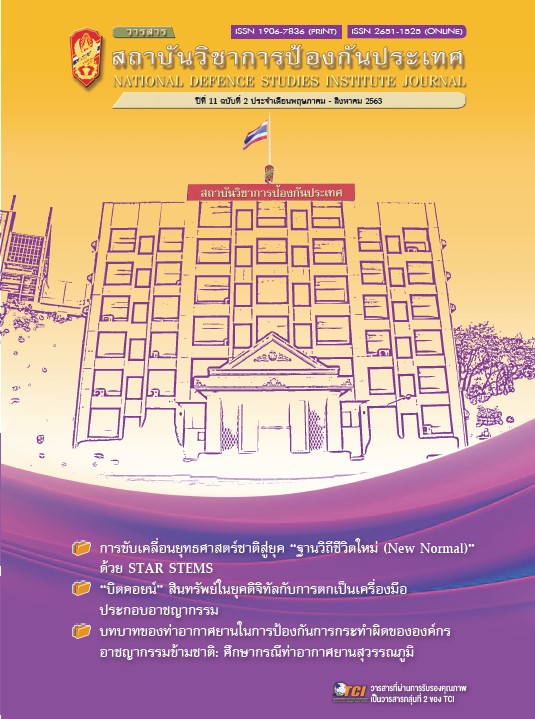ปัจจัยเชิงสาเหตุที่ส่งผลต่อการเป็นองค์กรสมรรถนะสูงของกรมแพทย์ทหารบก
Main Article Content
บทคัดย่อ
การวิจัยครั้งนี้มีวัตถุประสงค์ 1) เพื่อศึกษาวัฒนธรรมองค์กร ภาวะผู้นำการเปลี่ยนแปลง สมรรถนะของสมาชิกองค์กรความผูกพันต่อองค์กร และองค์กรสมรรถนะสูงในกรมแพทย์ทหารบก 2) เพื่อศึกษาอิทธิพลของวัฒนธรรมองค์กรภาวะผู้นำการเปลี่ยนแปลง สมรรถนะของสมาชิกองค์กร ความผูกพันต่อองค์กร ที่มีต่อองค์กรสมรรถนะสูงในกรมแพทย์ทหารบก 3) เพื่อศึกษารูปแบบความสัมพันธ์เชิงสาเหตุระหว่างวัฒนธรรมองค์กร ภาวะผู้นฃำการเปลี่ยนแปลง ผ่านสมรรถนะของสมาชิกองค์กร และความผูกพันต่อองค์กร ที่ส่งผลต่อการเป็นองค์กรสมรรถนะสูงในกรมแพทย์ทหารบก โดยการใช้ระเบียบวิธีวิจัยเชิงปริมาณ กลุ่มตัวอย่างที่ใช้ในการวิจัย คือ บุคลากรทางการแพทย์ ในหน่วยขึ้นตรงกรมแพทย์ทหารบกจำนวน 500 คน เครื่องมือที่ใช้ในการวิจัย เป็นแบบสอบถามมาตราส่วนประมาณค่า 5 ระดับ มีค่าความเชื่อมั่นทั้งฉบับ 0.97 สถิติที่ใช้ในการวิเคราะห์ข้อมูล คือ สถิติเชิงพรรณนา การวิเคราะห์สัมประสิทธิ์สหสัมพันธ์ และการวิเคราะห์โมเดล สมการโครงสร้าง ผลการวิจัยพบว่า 1) วัฒนธรรมองค์กร ภาวะผู้นำการเปลี่ยนแปลง สมรรถนะของสมาชิกองค์กร ความผูกพันต่อองค์กร และองค์กรสมรรถนะสูงของกรมแพทย์ทหารบก โดยรวมอยู่ในระดับมาก ( = 3.87, S.D. = 0.73) 2) ภาวะผู้นำการเปลี่ยนแปลง สมรรถนะของสมาชิกองค์กร และความผูกพันต่อองค์กร มีอิทธิพลทางตรง ต่อองค์กรสมรรถนะสูงของกรมแพทย์ทหารบก และภาวะผู้นำการเปลี่ยนแปลงวัฒนธรรมองค์กร มีอิทธิพลทางอ้อมต่อองค์กรสมรรถนะสูง โดยมีอิทธิพลผ่านสมรรถนะของสมาชิกองค์กร และความผูกพันต่อองค์กร อย่างมีนัยสำคัญทางสถิติที่ระดับ 0.01 3) ผลการวิเคราะห์รูปแบบความสัมพันธ์เชิงสาเหตุขององค์กรสมรรถนะสูงที่พัฒนาขึ้น มีความสอดคล้องกลมกลืนกับข้อมูลเชิงประจักษ์ มีค่า x2 = 119.15, df = 80,P-value = 0.098, GFI = 0.98, AGFI = 0.95, RMSEA = 0.04, RMR = 0.02 โดยรูปแบบความสัมพันธ์เชิงสาเหตุนี้สามารถอธิบายค่าความแปรปรวนขององค์กรสมรรถนะสูงได้ร้อยละ 98
Article Details
บทความ ภาพ ตาราง กราฟ ข้อเขียน หรือความคิดเห็นในวารสารฉบับนี้เป็นของผู้เขียนไม่ผูกพันกับสถาบันวิชาการป้องกันประเทศ และทางวิชาการแต่อย่างใด
เอกสารอ้างอิง
จิรประภา อัครบวร. (2549). สร้างคนสร้างผลงาน. กรุงเทพฯ: ก.พลพิมพ์ (1996).
ทิพวรรณ หล่อสุวรรณรัตน์. (2551). องค์กรสมรรถนะสูงกับความรับผิดชอบต่อสังคม. วารสารการจัดการภาครัฐและเอกชน
(2): 11-35
ปวลิน โปษยานนท์. (2557). การพัฒนารูปแบบเชิงโครงสร้างขององค์กรที่มีสมรรถนะสูงของบริษัทปูนซีเมนต์ไทย (แก่งคอย)
จำกัด (ดุษฎีนิพนธ์ปรัชญาดุษฎีบัณฑิต). มหาวิทยาลัยรามคำแหง.
พสุ เดชะรินทร์. (2549). การพัฒนาองค์การให้มีขีดสมรรถนะสูง. กรุงเทพฯ. วีชั่น พริ้นท์แอนมีเดีย.
วิชดา ประชุมทอง. (2551). สมรรถนะในการปฏิบัติงานของหัวหน้างานสายการผลิตกับประสิทธิผลขององค์การ บริษัท
ผลิตน้ำผลไม้กระป๋อง จังหวัดประจวบคีรีขันธ์. วารสารวิจัยและพัฒนา มหาวิทยาลัยราชภัฏสวนสุนันทา, 9(2), 136-151.
สำนักงานพัฒนาระบบราชการ. (2551). รายงานผลการศึกษาพัฒนารูปแบบเบื้องต้นของหน่วยงานภาครัฐ: องค์การที่มี
ขีดสมรรถนะสูง. กรุงเทพฯ. (อัดสำเนา).
Avolio, B. and Bass, B. (1995). Multifactor Leadership Questionnaire. Retrieved August 27, 2013, from
https://www.mindgarden.com/documents/MLQGermanPsychometric.pdf, August 27, 2013.
Beer, Michael. (2009). High Commitment High Performance: How to Build the Resilient Organization
for Sustained Advantage. San Francisco: Jossey- Bass
Bin Dost, et al. (2011). Impact of employee commitment on organizational performance. Arabian
Journal of Business and Management Review. 1(3).
Chughtai, A.A. and Zafar, S. (2006). Antecedents and Consequences of Organizational Commitment
among Pakistani University Teachers. (Applied Human Resource Management Research).
De Waal, A.A. (2004). “The role of information technology in the high performance organization.”
Business Strategy Series. 83(3): 179-185.
______. (2012). What make a high performance organization: Five valid factors of competitive
advantage that apply worldwide. UK: Global Professional Publishing.
De Waal, A.A. and Akaraborworn, C.T. (2013). Is the high performance organization framework suitable
for Thai organizations?. Measuring Business Excellence 17(4), 76-87.
De Waal, A.A. and Sultan, S. (2012). “Applicability of the high performance framework in the middle east:
the case of palestine polytechnic university.” Educational, Business and Society: Contemporary
Middle Eastern 5(3): 213-223.
Drous, S. (2004). Distance education to distributed learning: Multiple formats and technologies in
language instruction. CALICO journal. 15(3), 63-82.
Eisenbach, R., Watson, K. and Pillai, R. (1999). Transformational leadership in the context of organizational
change. Journal of Organizational Change. 12, 80-88.
Hair, J.F., Black, W.C., Babin, B. J., Anderson, R.E., and Tatham, R.L. (2010). Multivariate Data Analysis.
Upper Saddle River, New Jersey: Prentice-Hall.
Hastings Edmund, J. S. (1993). An analysis of labels for people with learning disabilities. British Journal
of Clinical Psychology, 32(4).
Hayter, R. (1997). “High performance organizations and employment flexibility: a case study of in situ
change at the powell river paper mill, 1980-1994.” The Canadian Geographers, 4(1), 26-40.
Hersey, P., & Blanchard, K. H. (1993). Management of organizational behavior. Utilizing human resources
(6th ed). Englewood Cliffs, NJ: Prentice Hall.
Kim, J.W., Choi, J., Qualls, W., & Park, J. (2004). The impact of CRM on firm-and relationship level
performance in distribution networks. Communications of the Association for Information
Systems, 14, 632-652.
Konovsky, M. A., & Cropanzano, R. (1991). Perceived Fairness of Employee Drug Testing as Predictor of
Employee Attitudes and Job Performance. Journal of Applied Psychology, 76, 698-707.
Kotter, J.P. and J.L. Heskett. (1992). Corporate Culture and Performance. New York: The Free Press.
Lawler, E.E. (1996). From the Ground Up: Six Principles for Building the New Logic Corporation.
San Francisco. CA: Jossey-Bass.
McClelland, C. (1999). Identifying Competencies with Behavioral-event interviews. Psychological
Science, 9(5). Retrieved December 11, 2018, from www.eiconsortium.org/research/business
case for ei.htm
Meyer, J.P. and Allen, N.J. (1997). Commitment in the Workplace. (Theory, Research and Application).
Schumacher, L. K. and Meleis, I. A. (1994). Transitions: A Central Concept in Nursing. Journal of Nursing
Scholarship, 26(2), 119-127.
Spreitez, G.M. (1995). Psychological empowerment in the workplace: dimensions, measurement and
validation. Academy of Management Journal, 38(5).
Steers, R.M. and Porter, L. (1979). “The measurement of organizational commitment.” Journal of Vocational
Behavior, 14, 224-247.
Wang, F.J., Chich-Jen, S., and Mei-Ling, T. (2010). “Effect of leadership style on organizational performance
as viewed from human resource management strategy.” African Journal of Business Management,
(18), 3924-3936.


